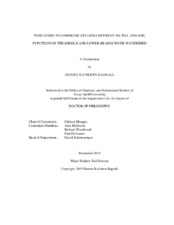| dc.contributor.advisor | Morgan, Cristine L.S. | |
| dc.creator | Bagnall, Dianna K | |
| dc.date.accessioned | 2020-09-09T19:54:05Z | |
| dc.date.available | 2021-12-01T08:43:50Z | |
| dc.date.created | 2019-12 | |
| dc.date.issued | 2019-09-27 | |
| dc.date.submitted | December 2019 | |
| dc.identifier.uri | https://hdl.handle.net/1969.1/188976 | |
| dc.description.abstract | Adoption of no-till is low in the Lower and Middle Brazos River Watershed of Texas, leaving soil vulnerable to erosion, exacerbating flooding, and contributing to high nutrient and sediment levels in surface waters. To aid in the adoption of no-till, changes in soil health need to be measured and related to things that both clearly and directly matter to farmers and stakeholders, yet soil scientists are grappling with which indicators to measure when assessing soil health. We investigated which indicators of soil health were meaningful to farmers using qualitative analysis of transcripts from focus groups. We also measured whether these indicators were changing as a result of no-till adoption in farmers’ fields. We collected soil health measurements in perennial fields as a benchmark to compare both no-till and conventional tillage. Farmers were concerned about profitability and influenced by social interactions, but soil health remained an important concern for them when making management decisions.
Organic matter and “water management” were the indicators of soil health farmers found most meaningful. Organic carbon was significantly higher in no-till compared to conventionally-tilled fields. Conventional fields had significantly lower saturated hydraulic conductivity than perennial fields. Saturated hydraulic conductivity was 1.3 cm h-1 higher in no-till than in conventional fields. Soil structure measured from 10- to 30-cm depth was significantly improved in no-till compared to conventional fields. These improvements in organic matter and hydraulic function are meaningful indicators of soil health that can be used to promote no-till adoption and provide ecosystem services to off-site stakeholders who are impacted by erosion and sedimentation resulting from conventional tillage. | en |
| dc.format.mimetype | application/pdf | |
| dc.language.iso | en | |
| dc.subject | Soil health | en |
| dc.subject | farmer interview | en |
| dc.title | Indicators to Communicate Links Between No-Till and Soil Functions in the Middle and Lower Brazos River Watershed | en |
| dc.type | Thesis | en |
| thesis.degree.department | Soil and Crop Sciences | en |
| thesis.degree.discipline | Soil Science | en |
| thesis.degree.grantor | Texas A&M University | en |
| thesis.degree.name | Doctor of Philosophy | en |
| thesis.degree.level | Doctoral | en |
| dc.contributor.committeeMember | Woodward, Richard T | |
| dc.contributor.committeeMember | McIntosh, Wm. A | |
| dc.contributor.committeeMember | De Laune, Paul | |
| dc.type.material | text | en |
| dc.date.updated | 2020-09-09T19:54:06Z | |
| local.embargo.terms | 2021-12-01 | |
| local.etdauthor.orcid | 0000-0001-6687-1923 | |


